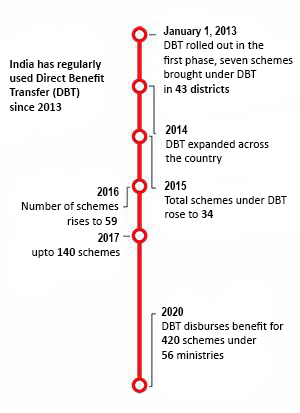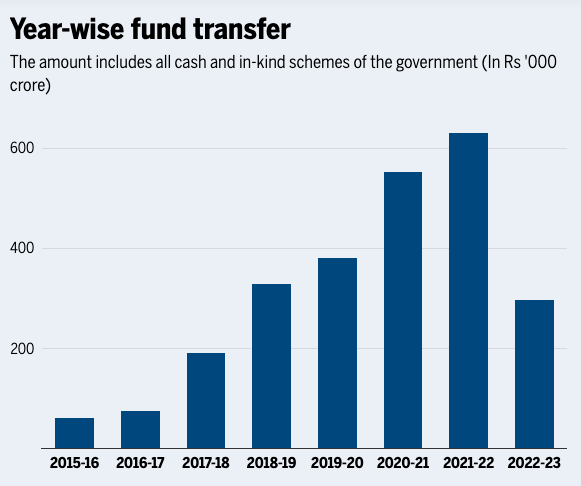ForumIAS announcing GS Foundation Program for UPSC CSE 2025-26 from 19 April. Click Here for more information.
Contents
| For 7PM Editorial Archives click HERE → |
Introduction
The International Monetary Fund (IMF) has praised the Direct Benefit Transfer (DBT) Scheme, calling it a ‘logistical marvel‘ that has reached hundreds of millions of people. An IMF Deputy Director said that DBT programme has helped people with low income levels especially women and the elderly praising the technological innovation behind it. Further, developing countries can learn a lot from India’s DBT initiative. Earlier, the President of the World Bank Group had also urged other nations to adopt India’s move of targeted cash transfers instead of broad subsidies, noting that “India managed to provide food or cash support to 85% of rural households and 69% of urban households”. The DBT scheme has proved to be a remarkably successful endeavour in providing support to the poor and ensure inclusive growth. The Government can take steps to plug some gaps to enhance its efficacy further.
What is Direct Benefit Transfer (DBT)?
The Direct Benefit Transfer (DBT) programme was launched on January 01, 2013. It was initiated with the goal of improving the delivery system of the welfare initiatives of the Government of India and reforming the procedures of existing social schemes. The program has aimed at transfer of subsidies and cash benefits directly to the people through their Aadhaar seeded bank accounts. While launching, it was hoped that crediting subsidies into the bank accounts would substantially reduce leakages, and associated delays. Earlier the funds flowed through a multiple layers of administrative offices till it reaches the end beneficiary, invariably leading to delays. DBT has eliminated the extra layers.
Source: National Informatics Centre
What are the components and types of schemes covered under the Direct Benefit Transfer (DBT)?
Components
Primary components in the implementation of DBT schemes include: (a) Beneficiary Account Validation System; (b) A robust payment and reconciliation platform integrated with RBI, NPCI and Beneficiary Banks (Public/Private Sector Banks, Regional Rural Banks and Cooperative Banks). It includes the Core Banking Solutions of banks, Settlement Systems of RBI, Aadhaar Payment Bridge of NPCI.
Types Of Schemes
Cash Transfer: Under the cash transfer scheme of Direct Benefit Transfer, the Government directly transfers the money to the individual beneficiaries. The cash transfer is undertaken through: (a) Direct transfer to beneficiary account by Union Government; (b) Transfer through State Treasury Account; (c) Cash transfer by implementing agency of the Government.
Source: The Times of India
In-Kind benefit transfer: In-kind benefit transfer is a scheme of Direct Benefit Transfer where the Government offers benefits to the beneficiaries in kind either directly or through their implementing agencies. Here, the Government incurs the expense of procuring a subsidy or benefit. For instance, the Government will buy a particular product, say food grains and offer it for public distribution.
Source: The Times of India
Other transfers: Other than cash and kind transfers, the Direct Benefits Transfer scheme also transfers funds and subsidies to several non-governmental functionaries that help implement government policies until the very end. This includes community workers, NGOs, teachers in aided schools, etc. They are not beneficiaries but are given training, wages, and incentives to serve the beneficiaries.
What are the advantages of Direct Benefit Transfer (DBT)?
Good Governance: (a) It has brought transparency and reduced instances of pilferage from the distribution of Central Government-sponsored funds; (b) Disbursal based on verification of biometric identity through Aadhar has reduced fraudulent and duplicate beneficiaries; (c) The Direct Benefit Transfer (DBT) programmes have provided for time-bound transfers of benefits, which has helped recipients avoid delays in the transfer of money. This was one of the most significant challenges they faced earlier.
Benefit to the Economy: (a) As the subsidies and benefits are being transmitted directly, DBT scheme has eliminated the need for intermediaries and rentals for ‘fair pricing’ shops etc. This is proving to be beneficial to the Indian economy as a result of the reduction in structural expenditures; (b) It is no longer a concern that middlemen are taking subsidised grains and selling them on the market; (c) It is also expected that the amount of money that is being circulated will be raised, which has the potential to result in a large rise in the GDP.
Digitalisation or Cashless Economy: (a) DBT is assisting India in accelerating its transition toward a cashless economy; (b) The prospect of receiving money directly has motivated people to open bank accounts and also acting as a driver in promoting savings.
Source: The Times of India
What steps can be taken to improve the Direct Benefit Transfer (DBT) further?
A private sector consulting firm has suggested some measures to further enhance the effectiveness of the DBT.
First, India has created a strong Direct Benefit Transfer (DBT) system, but there is a need to focus more on user-centricity. The Government should include women, persons with disabilities, and other traditionally excluded/vulnerable groups in the design process (following the ‘Principles of Digital Development’). The system should address common consumer risks, such as unreliable network or service, complex user interfaces, and inadequate payment processes that force recipients to ask others for assistance and share personal information.
Second, despite efforts by Government, it was found that several beneficiaries were not aware of their entitlements and missed out on benefits. Governments should adopt a strategic approach to Awareness, Communication, and Outreach (ACO) for G2P (Government to Person) programs. The Government should have dedicated campaigns keeping in mind low level of literacy among beneficiaries. Moreover, Beneficiaries should be given the opportunity to provide feedback on the programme as well as the manner in which benefits are distributed. This would enable the Government to take corrective steps in case of any gaps.
Third, During times of crises (like COVID-19 pandemic), it is more beneficial to ramp up already established programmes rather than launching new support schemes. The beneficiaries are already aware of the programme and the process. To make this more efficient, a dynamic database (updated on real-time basis) of social safety programmes that are categorised according to families and segments, such as occupation, gender, condition, and income level should be maintained.
Fourth, A survey found that ~10% DBT beneficiaries avail benefits through Banking Correspondents (BCs). To ensure the efficiency of service delivery and offer proper monetary incentives, the Union and State Governments, and financial institutions should monitor the functioning and incentive structure of BCs on a regular basis. Governments and Banks should ensure adequate compensation for BCs, motivating them to improve last-mile payment delivery. Furthermore, it should assist them in establishing confidence with their customers in order to do more transactions.
The Governments should also allow BC agents to ‘white-label’ their services to multiple banks, which means BCs can sell products from multiple banks to a customer. This will help in enhancing reach and last-mile delivery.
Fifth, Governments should deliver cash benefits at the doorstep while ensuring correct targeting. Doorstep delivery of cash benefits has been instrumental in providing a safety net to those who cannot travel to access points (like the elderly, differently-abled, and women customers constrained by safety concerns or regressive social norms).
Sixth, Governments should create an enabling environment and promote the use of the digital payments. This will allow beneficiaries to use the benefit amount without visiting a withdrawal point, which would save them time and cost. Again, the facility will help the elderly, women and differently-abled beneficiaries.
Seventh, the Government should design a robust beneficiary-centric grievance resolution mechanism. The current DBT architecture lacks an effective mechanism for customers to resolve grievances like non-receipt of funds or transaction failure. Between April-June 2020 ~1.47% of 830 million (i.e. ~12 million) transactions failed. Technology solutions should be developed to identify, monitor and rectify issues like transaction failure or delays. Beneficiaries should be provided with simple process to raise grievance and implementing agency responsible for the transaction failure or delays should resolve the issues immediately.
Conclusion
During the COVID-19 pandemic, the Government of India used the DBT system to transfer US$ 3.9 billion (INR 282 billion) to 318 million beneficiaries two weeks after announcing the PMGKY program. Overall, the Government of India deposited US$ 9.3 billion (INR 680 billion) in the bank accounts of over 420 million beneficiaries under PMGKY. This large-scale transfer showed the robust nature of the cash transfer system in India and ensured timely, efficient, and convenient transfers during the pandemic. No wonder the global agencies have praised the Government’s efforts. Now the Government should further enhance the efficacy of the Direct Benefit Transfer programme, eliminate the loopholes like transaction failures and make the system completely foolproof.
Syllabus: GS II, Government policies and interventions for development in various sectors and issues arising out of their design and implementation; Welfare schemes for vulnerable sections of the population by the Centre and States and the performance of these schemes.
Source: Indian Express, The Times of India, National Informatics Centre, Microsave








